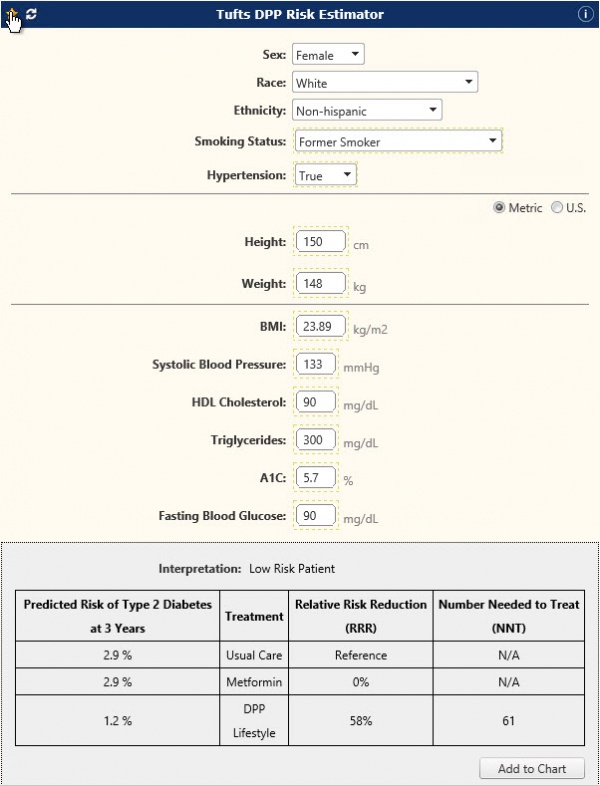Difference between revisions of "Galen eCalcs - Calculator: Tufts DPP Risk Estimator"
Jump to navigation
Jump to search
| Line 3: | Line 3: | ||
== Description == | == Description == | ||
This is a calculator designed to accompany a research study driven by Tufts University that is investigating the relative risk reduction of adopting a DPP lifestyle on type 2 diabetes onset. | This is a calculator designed to accompany a research study driven by Tufts University that is investigating the relative risk reduction of adopting a DPP lifestyle on type 2 diabetes onset. | ||
| + | |||
===Limitations=== | ===Limitations=== | ||
This calculator was not designed for client-wide utilization and is not recommended to use this calculator unless the organization is part of the study. | This calculator was not designed for client-wide utilization and is not recommended to use this calculator unless the organization is part of the study. | ||
| + | |||
===Ranges=== | ===Ranges=== | ||
| Line 31: | Line 33: | ||
|Use Blood Glucose Fasting Logic || || | |Use Blood Glucose Fasting Logic || || | ||
|} | |} | ||
| + | |||
== Calculator Inputs == | == Calculator Inputs == | ||
| Line 66: | Line 69: | ||
|Weight || Vital Signs || Patient’s weight | |Weight || Vital Signs || Patient’s weight | ||
|} | |} | ||
| + | |||
== Calculator Outputs == | == Calculator Outputs == | ||
Revision as of 17:48, 18 December 2019
Description
This is a calculator designed to accompany a research study driven by Tufts University that is investigating the relative risk reduction of adopting a DPP lifestyle on type 2 diabetes onset.
Limitations
This calculator was not designed for client-wide utilization and is not recommended to use this calculator unless the organization is part of the study.
Ranges
Target patients are prediabetic patients aged 25-75.
Calculator Configuration Options
| Preference Name | Valid Range | Description |
|---|---|---|
| Publishing | Checked / Unchecked | When checked the calculator will display for users on the front end. When unchecked, the calculator WILL NOT display for users on the front end. |
| Fasting Blood Glucose Warning | ||
| Inputs Maximum Days Age | ||
| Lab Differential Threshold | ||
| Orderable Item Override | (BLANK) / G-DPP | “(BLANK)” indicates that the global configuration options for Orderable Item will be used. “G-DPP” indicates that the calculator specific value will be used and can display the specific calculator name in the output. |
| Save Discrete Results | True/False | When True, saves the questions and results of the calculator discretely when saving the results of the calculator. |
| Use Blood Glucose Fasting Logic |
Calculator Inputs
| Input | Mapping Type | Description |
|---|---|---|
| A1C | Results | Patient’s A1C value |
| Blood Glucose | Results | Patient’s blood/plasma glucose value |
| BMI | Vital Signs | Patient’s BMI |
| Current Smoker | Problems | Patient is a current smoker |
| Fasting Blood Glucose | Results | Patient's fasting blood/plasma glucose level |
| Fasting Other | Results | Any fasting lab other than a fasting blood/plasma glucose |
| Former Smoker | Problems | Patient is a former smoker |
| HDL Cholesterol | Results | Patient’s HDL cholesterol value |
| Height | Vital Signs | Patient’s height |
| Hypertension | Problems | Patient’s hypertension problem status |
| Non-smoker | Problems | Patient has never been a smoker |
| Systolic Blood Pressure | Vital Signs | Patient’s systolic blood pressure |
| Triglycerides | Results | Patient’s triglyceride value |
| Weight | Vital Signs | Patient’s weight |
Calculator Outputs
| Output | Mapping Type | Description |
|---|---|---|
| DPP NNT | Result | The average number of patients who need to be adopting the DDP lifestyle treatment to prevent one additional case of developing type 2 diabetes in the next 3 years |
| DPP Risk | Result | Risk of developing type 2 diabetes in the next 3 years with the |
| Interpretation | Result | Interpretation of calculator’s results |
| Metformin NNT | Result | The average number of patients who need to be treated with Metformin to prevent one additional case of developing type 2 diabetes in the next 3 years |
| Metformin Risk | Result | The risk of developing type 2 diabetes in the next 3 years with Metformin treatment |
| Usual Care Risk | Result | Risk of developing type 2 diabetes in the next 3 years with the usual care treatment |
